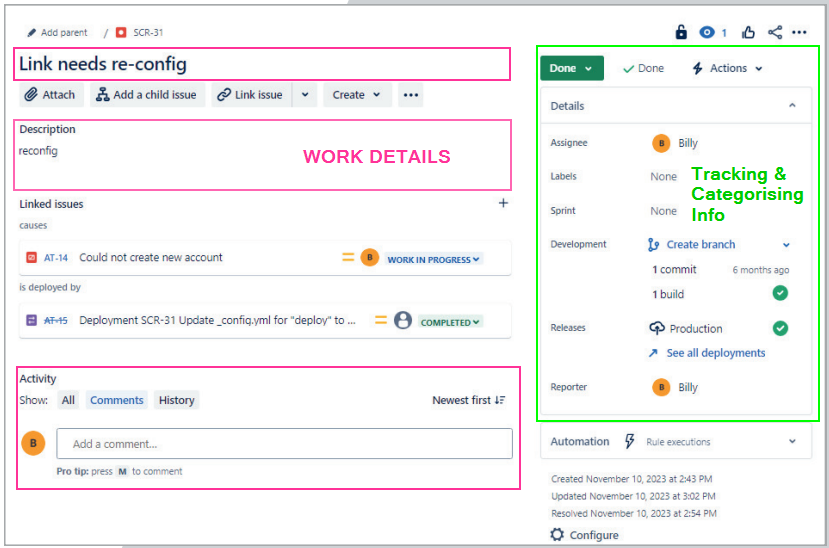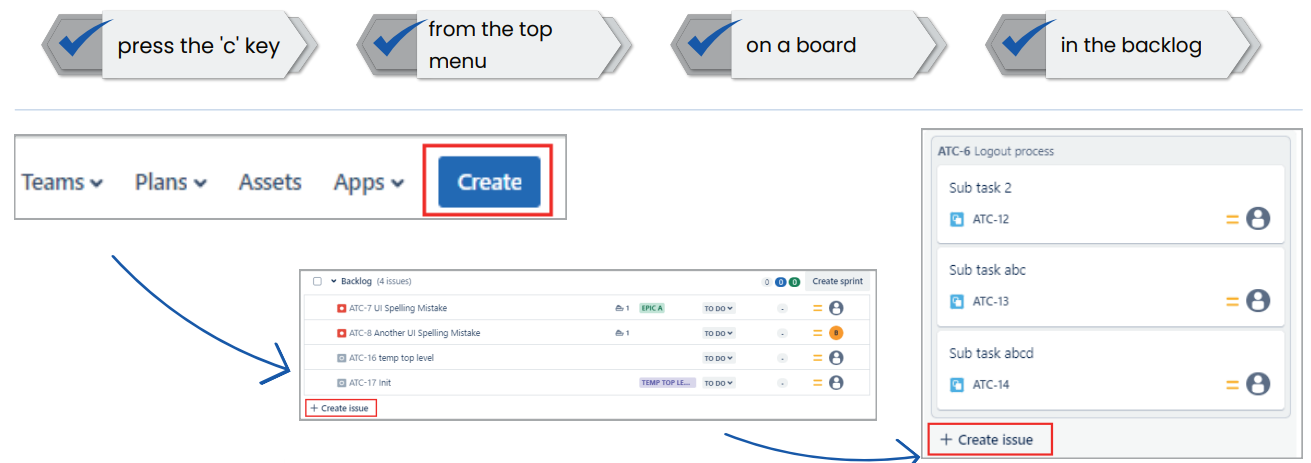Understanding JIRA “Issues" is key to managing projects in Jira. For legacy reasons, in Jira, records are known as “Issues". When JIRA started out as a defect bug and issue tracking software tool, a record was known as an issue. However, use of Jira well beyond defect and bug tracking, has grown.
You'll find it easier to think of an issue in JIRA as a record used to track a unit of work. Every record in JIRA is a record of information that we're using to track a particular piece and type of work. You could think of an issue as a “digital card" that holds all the details about a piece of work that needs to be completed.
Issues that track a piece of work need structure to be useful. You can break down the record into two categories of information. Firstly, information about the work you want to complete. Things like the summary, the description of the work. Also things like comments, history and a log of all of the work you completed.
The second area covers the properties that help us track these issues. This might include things like the priority of the work, estimates on the amount of work that is involved, who the task is assigned to, who reported it, and all sorts of other customizable metadata. It's this metadata that helps you group, track and categorize the issues that you're working with.

Here's how JIRA organizes information in each issue.
Work Details:
Tracking and Categorising Info:
So how do we create an issue to track a unit of work we need to complete?
When you want to create a new issue, you can use the “Create" button or you can press the “C" key on the keyboard. Both ways will bring up the Create new issue window. There are a few other ways to create new issues too (shown in the diagram below)

The Create new issue dialogue box then expects you to enter the core mandatory data. This covers some key Tracking and Categorising Info plus details about the work.
When you create your issue these are the first three key pieces of data that matter:
When you enter data to create your issue, you must specify the project it belongs to and the type of work it is (task, story, bug, epic, or test). Each issue also has a status that tracks its progress through customizable workflows, typically moving from “to-do" through “in progress" to “done.". Issue types and Statu can be customized to match your project's real life way of working.
JIRA’s Summary and Description fields are next. These two fields detail what needs to be done, why it’s needed and any additional detail about the work that needs to be completed.
Summary: A brief, clear title that captures the core purpose of the piece of work.
Description: The detailed explanation that provides all necessary information to understand and complete the work. This should include:
Good descriptions ensure team members can understand and the unit of work without needing to ask for clarification.
That’s the basics covered. In fact, that’s all the core details you need to create a new issue. There’s more you can capture if you need to though.
Once you've entered the core data you can embelish your record with more detail if you need to. We explain in more detail other aspects of your issue below. First it's worth understanding more about Issue Types and how Jira implements a hierarchy of issues types.
You've already categorised your issue by setting an “Issue Type" value (e.g. task, story, bug, epic, test). Categorising your issues by “Issue Type" helps your organise your work and helps your teams work better. JIRA takes this further than just having “Issue Type" categories by using three levels to keep work organized.
The default Jira setup comes with these three levels in the hierarchy as standard. As you become more familiar with Jira you will find that you can create other levels above Epics if you need to. That's a topic for another day though.
Beyond the core fields we've discussed above, JIRA offers many other fields for you to help categorise and organise your work. Here are some of the other common fields and data you can store:
We'll get into all of these fields in later posts and explain how you can use this data to find, filter and report on issues based on this data.
Another core concept in Jira is the ability to track work as it moves through different stages (more commonly known as “status"). The simplest form of tracking the progress of your work might be tracking an issue based on it's status being one of the following values:
You can customise these Status values to match how your team works. You can even create relationships between status values so that you can model your real world workflow.

We're going to get into this in far more detail in future posts.
Just to summarise the most important concepts then. When creating a JIRA issue, you must specify the project it belongs to and its task type (task, story, bug, epic, or test). Each issue has a status value that tracks its progress through a workflows, typically moving from “To Do" through “In Progress" to “Done.“
It's the Summary field and the Description that actually describes the work that needs to be completed. You can aslo keep track of what's happened to this unit of work by following the updates in the Activity section (e.g. Comments, History, etc) of the Jira record too. Then there's other meta data we can track that includes information like who the work is assigned to, who created the record and much, much more.
In the next post and video we look in more detail at Jira Projects.